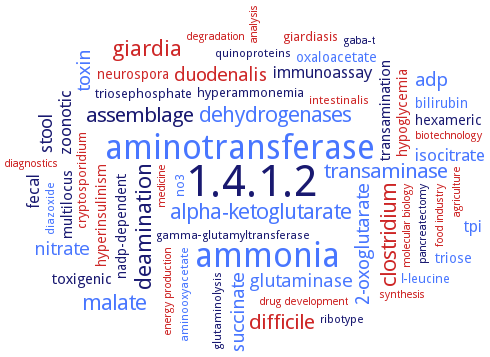1.4.1.2: glutamate dehydrogenase
This is an abbreviated version!
For detailed information about glutamate dehydrogenase, go to the full flat file.

Word Map on EC 1.4.1.2 
-
1.4.1.2
-
ammonia
-
aminotransferase
-
giardia
-
deamination
-
dehydrogenases
-
malate
-
alpha-ketoglutarate
-
clostridium
-
difficile
-
assemblage
-
transaminase
-
succinate
-
duodenalis
-
adp
-
2-oxoglutarate
-
toxin
-
nitrate
-
stool
-
glutaminase
-
zoonotic
-
isocitrate
-
immunoassay
-
fecal
-
tpi
-
transamination
-
multilocus
-
toxigenic
-
neurospora
-
hyperinsulinism
-
triose
-
hypoglycemia
-
oxaloacetate
-
nadp-dependent
-
bilirubin
-
hexameric
-
hyperammonemia
-
giardiasis
-
triosephosphate
-
l-leucine
-
cryptosporidium
-
no3
-
aminooxyacetate
-
intestinalis
-
ribotype
-
quinoproteins
-
gamma-glutamyltransferase
-
glutaminolysis
-
diazoxide
-
degradation
-
agriculture
-
biotechnology
-
gaba-t
-
drug development
-
medicine
-
molecular biology
-
pancreatectomy
-
analysis
-
food industry
-
energy production
-
diagnostics
-
synthesis
- 1.4.1.2
- ammonia
- aminotransferase
- giardia
-
deamination
- dehydrogenases
- malate
- alpha-ketoglutarate
- clostridium
- difficile
-
assemblage
- transaminase
- succinate
- duodenalis
- adp
- 2-oxoglutarate
- toxin
- nitrate
-
stool
- glutaminase
-
zoonotic
- isocitrate
-
immunoassay
-
fecal
- tpi
-
transamination
-
multilocus
-
toxigenic
- neurospora
- hyperinsulinism
- triose
- hypoglycemia
- oxaloacetate
-
nadp-dependent
- bilirubin
-
hexameric
-
hyperammonemia
- giardiasis
-
triosephosphate
- l-leucine
- cryptosporidium
- no3
- aminooxyacetate
- intestinalis
-
ribotype
-
quinoproteins
- gamma-glutamyltransferase
-
glutaminolysis
- diazoxide
- degradation
- agriculture
- biotechnology
- gaba-t
- drug development
- medicine
- molecular biology
-
pancreatectomy
- analysis
- food industry
- energy production
- diagnostics
- synthesis
Reaction
Synonyms
At5g18170, AtGDH1, BpNADGDH, c, CCNA_00086, CsGDH, dehydrogenase, glutamate, GDH, GDH isoenzyme 1, GDH, NAD-dependent, gdh-1, gdh-2, GDH1, GDH2, Gdh2p, GDH3, GdhA, GDHB, GDHI, GdhZ, Glu dehydrogenase, GluD, GLUD1, GLUD2, GluDH, glutamate dehydrogenase, glutamate dehydrogenase (NAD), glutamate dehydrogenase 2, glutamate dehydrogenase alpha subunit, glutamate dehydrogenase beta subunit, glutamate dehydrogenase isoform 1, glutamate oxidoreductase, glutamic acid dehydrogenase, glutamic dehydrogenase, hGDH1, hGDH2-nerve-specific GDH, house-keeping GDH, L-glutamate dehydrogenase, L-glutamic acid dehydrogenase, More, NAD(+)-dependent glutamate dehydrogenase, NAD(H)-dependent glutamate dehydrogenase, NAD+-dependant glutamate dehydrogenase, NAD+-dependent GDH, NAD+-dependent GDHX, NAD+-dependent GluDH, NAD+-dependent glutamate dehydrogenase, NAD+-GDH, NAD+-glutamate dehydrogenase, NAD+-specific GDH, NAD+-specific glutamate dehydrogenase, NAD-dependent GDH, NAD-dependent glutamate dehydrogenase, NAD-dependent glutamic dehydrogenase, NAD-dependent L-glutamate dehydrogenase, NAD-GDH, NAD-glutamate dehydrogenase, NAD-linked glutamate dehydrogenase, NAD-linked glutamic dehydrogenase, NAD-specific glutamate dehydrogenase, NAD-specific glutamic dehydrogenase, NAD-ylGdh2p, NAD:glutamate oxidoreductase, NADH-dependent GDH, NADH-dependent glutamate dehydrogenase, NADH-GDH, NADH-glutamate dehydrogenase, NADH-linked glutamate dehydrogenase, OsGDH1, OsGDH2, OsGDH3, Pcal_1031, RocG, sco2999, Surface-associated protein PGAG1, t-GDH, type I GDH, YALI0E09603g, ylGDH2


 results (
results ( results (
results ( top
top






